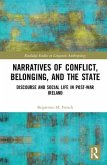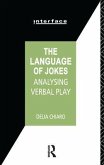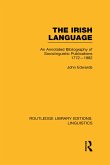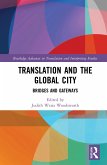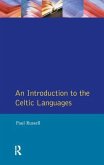Andere Kunden interessierten sich auch für
![Narratives of Conflict, Belonging, and the State Narratives of Conflict, Belonging, and the State]() Brigittine M. FrenchNarratives of Conflict, Belonging, and the State167,99 €
Brigittine M. FrenchNarratives of Conflict, Belonging, and the State167,99 €![The Language of Jokes The Language of Jokes]() Delia ChiaroThe Language of Jokes167,99 €
Delia ChiaroThe Language of Jokes167,99 €![The Irish Language (RLE Linguistics E The Irish Language (RLE Linguistics E]() John EdwardsThe Irish Language (RLE Linguistics E171,99 €
John EdwardsThe Irish Language (RLE Linguistics E171,99 €![The Impact of Global English on Cultural Identities in the United Arab Emirates The Impact of Global English on Cultural Identities in the United Arab Emirates]() Sarah HopkynsThe Impact of Global English on Cultural Identities in the United Arab Emirates167,99 €
Sarah HopkynsThe Impact of Global English on Cultural Identities in the United Arab Emirates167,99 €![Discourses of Global Queer Mobility and the Mediatization of Equality Discourses of Global Queer Mobility and the Mediatization of Equality]() Joseph ComerDiscourses of Global Queer Mobility and the Mediatization of Equality167,99 €
Joseph ComerDiscourses of Global Queer Mobility and the Mediatization of Equality167,99 €![Translation and the Global City Translation and the Global City]() Translation and the Global City167,99 €
Translation and the Global City167,99 €![An Introduction to the Celtic Languages An Introduction to the Celtic Languages]() Paul RussellAn Introduction to the Celtic Languages169,99 €
Paul RussellAn Introduction to the Celtic Languages169,99 €-
-
-
Produktdetails
- Verlag: Routledge
- Seitenzahl: 214
- Erscheinungstermin: 5. März 2020
- Englisch
- Abmessung: 235mm x 157mm x 16mm
- Gewicht: 468g
- ISBN-13: 9781138243385
- ISBN-10: 1138243388
- Artikelnr.: 59008694
- Herstellerkennzeichnung
- Libri GmbH
- Europaallee 1
- 36244 Bad Hersfeld
- gpsr@libri.de
Contents
Acknowledgements
Figure 1 Map illustrating Language Planning Process
Figure 2 Transcription protocol
Chapter 1: Re-thinking the Sociolinguistics of Irish
Introduction
Disrupting old ideas, creating new tensions
Giving a voice to new speakers
John's story
Bernie's story
Outline of book
Chapter 2: New speakers, new paradigms? Building a theoretical framework
Introduction
New speaker research: origins and developments
New speakers and broader debates around language and society
Native speaker ideologies in language revitalisation movements
New speakers, new paradigms?
New speakers of minority languages: questions of authenticity, authority,
and legitimacy
Rethinking new labels and frameworks
Conclusion
Chapter 3: National, official and minoritised: the context and background
of Irish
Introduction
Revival period and new speakers
Phases of language policy and new speakers
Gaeltacht
Legal and administrative status
Irish in the education system
Standardisation
Irish in Northern Ireland
Recent policy initiatives and Irish language networks
Conclusion
Chapter 4: Becoming a new speaker of Irish
Introduction
Fieldwork conducted by John
Clár
Karen
Roibeárd
Cian
Jason
Fieldwork conducted by Bernie
Máire
Joanne
Liam
Micheál
Jane
Conclusion
Chapter 5: New speakers of Irish and identities
Introduction
Irish speakers and identities
Primary Irish-speaking identity
Irish language identity linked to standard language or dialect
Ambiguous or mixed linguistic identity
Primary English-speaking identity
Intersection of linguistic and sexual identities
Conclusion
Chapter 6: Ciorcail chomhrá - 'safe spaces' for the cúpla focal
Introduction
The ciorcal comhrá phenomenon
Safe spaces and 'breathing spaces' for the language
New speakers at Cluain Lí
Tá cúpla focal agam - 'I have the few words'
The ciorcal comhrá as a 'safe place' to use Irish
Expert speakers and the native speaker ideology
Beyond the ciorcal comhrá: the Gaeltacht as an authentic space
Conclusion
Chapter 7: Conclusions
New speaker stories
Theoretical insights from the study
Policy implications
New speakers and the Gaeltacht
References
Index
Acknowledgements
Figure 1 Map illustrating Language Planning Process
Figure 2 Transcription protocol
Chapter 1: Re-thinking the Sociolinguistics of Irish
Introduction
Disrupting old ideas, creating new tensions
Giving a voice to new speakers
John's story
Bernie's story
Outline of book
Chapter 2: New speakers, new paradigms? Building a theoretical framework
Introduction
New speaker research: origins and developments
New speakers and broader debates around language and society
Native speaker ideologies in language revitalisation movements
New speakers, new paradigms?
New speakers of minority languages: questions of authenticity, authority,
and legitimacy
Rethinking new labels and frameworks
Conclusion
Chapter 3: National, official and minoritised: the context and background
of Irish
Introduction
Revival period and new speakers
Phases of language policy and new speakers
Gaeltacht
Legal and administrative status
Irish in the education system
Standardisation
Irish in Northern Ireland
Recent policy initiatives and Irish language networks
Conclusion
Chapter 4: Becoming a new speaker of Irish
Introduction
Fieldwork conducted by John
Clár
Karen
Roibeárd
Cian
Jason
Fieldwork conducted by Bernie
Máire
Joanne
Liam
Micheál
Jane
Conclusion
Chapter 5: New speakers of Irish and identities
Introduction
Irish speakers and identities
Primary Irish-speaking identity
Irish language identity linked to standard language or dialect
Ambiguous or mixed linguistic identity
Primary English-speaking identity
Intersection of linguistic and sexual identities
Conclusion
Chapter 6: Ciorcail chomhrá - 'safe spaces' for the cúpla focal
Introduction
The ciorcal comhrá phenomenon
Safe spaces and 'breathing spaces' for the language
New speakers at Cluain Lí
Tá cúpla focal agam - 'I have the few words'
The ciorcal comhrá as a 'safe place' to use Irish
Expert speakers and the native speaker ideology
Beyond the ciorcal comhrá: the Gaeltacht as an authentic space
Conclusion
Chapter 7: Conclusions
New speaker stories
Theoretical insights from the study
Policy implications
New speakers and the Gaeltacht
References
Index
Contents
Acknowledgements
Figure 1 Map illustrating Language Planning Process
Figure 2 Transcription protocol
Chapter 1: Re-thinking the Sociolinguistics of Irish
Introduction
Disrupting old ideas, creating new tensions
Giving a voice to new speakers
John's story
Bernie's story
Outline of book
Chapter 2: New speakers, new paradigms? Building a theoretical framework
Introduction
New speaker research: origins and developments
New speakers and broader debates around language and society
Native speaker ideologies in language revitalisation movements
New speakers, new paradigms?
New speakers of minority languages: questions of authenticity, authority,
and legitimacy
Rethinking new labels and frameworks
Conclusion
Chapter 3: National, official and minoritised: the context and background
of Irish
Introduction
Revival period and new speakers
Phases of language policy and new speakers
Gaeltacht
Legal and administrative status
Irish in the education system
Standardisation
Irish in Northern Ireland
Recent policy initiatives and Irish language networks
Conclusion
Chapter 4: Becoming a new speaker of Irish
Introduction
Fieldwork conducted by John
Clár
Karen
Roibeárd
Cian
Jason
Fieldwork conducted by Bernie
Máire
Joanne
Liam
Micheál
Jane
Conclusion
Chapter 5: New speakers of Irish and identities
Introduction
Irish speakers and identities
Primary Irish-speaking identity
Irish language identity linked to standard language or dialect
Ambiguous or mixed linguistic identity
Primary English-speaking identity
Intersection of linguistic and sexual identities
Conclusion
Chapter 6: Ciorcail chomhrá - 'safe spaces' for the cúpla focal
Introduction
The ciorcal comhrá phenomenon
Safe spaces and 'breathing spaces' for the language
New speakers at Cluain Lí
Tá cúpla focal agam - 'I have the few words'
The ciorcal comhrá as a 'safe place' to use Irish
Expert speakers and the native speaker ideology
Beyond the ciorcal comhrá: the Gaeltacht as an authentic space
Conclusion
Chapter 7: Conclusions
New speaker stories
Theoretical insights from the study
Policy implications
New speakers and the Gaeltacht
References
Index
Acknowledgements
Figure 1 Map illustrating Language Planning Process
Figure 2 Transcription protocol
Chapter 1: Re-thinking the Sociolinguistics of Irish
Introduction
Disrupting old ideas, creating new tensions
Giving a voice to new speakers
John's story
Bernie's story
Outline of book
Chapter 2: New speakers, new paradigms? Building a theoretical framework
Introduction
New speaker research: origins and developments
New speakers and broader debates around language and society
Native speaker ideologies in language revitalisation movements
New speakers, new paradigms?
New speakers of minority languages: questions of authenticity, authority,
and legitimacy
Rethinking new labels and frameworks
Conclusion
Chapter 3: National, official and minoritised: the context and background
of Irish
Introduction
Revival period and new speakers
Phases of language policy and new speakers
Gaeltacht
Legal and administrative status
Irish in the education system
Standardisation
Irish in Northern Ireland
Recent policy initiatives and Irish language networks
Conclusion
Chapter 4: Becoming a new speaker of Irish
Introduction
Fieldwork conducted by John
Clár
Karen
Roibeárd
Cian
Jason
Fieldwork conducted by Bernie
Máire
Joanne
Liam
Micheál
Jane
Conclusion
Chapter 5: New speakers of Irish and identities
Introduction
Irish speakers and identities
Primary Irish-speaking identity
Irish language identity linked to standard language or dialect
Ambiguous or mixed linguistic identity
Primary English-speaking identity
Intersection of linguistic and sexual identities
Conclusion
Chapter 6: Ciorcail chomhrá - 'safe spaces' for the cúpla focal
Introduction
The ciorcal comhrá phenomenon
Safe spaces and 'breathing spaces' for the language
New speakers at Cluain Lí
Tá cúpla focal agam - 'I have the few words'
The ciorcal comhrá as a 'safe place' to use Irish
Expert speakers and the native speaker ideology
Beyond the ciorcal comhrá: the Gaeltacht as an authentic space
Conclusion
Chapter 7: Conclusions
New speaker stories
Theoretical insights from the study
Policy implications
New speakers and the Gaeltacht
References
Index


